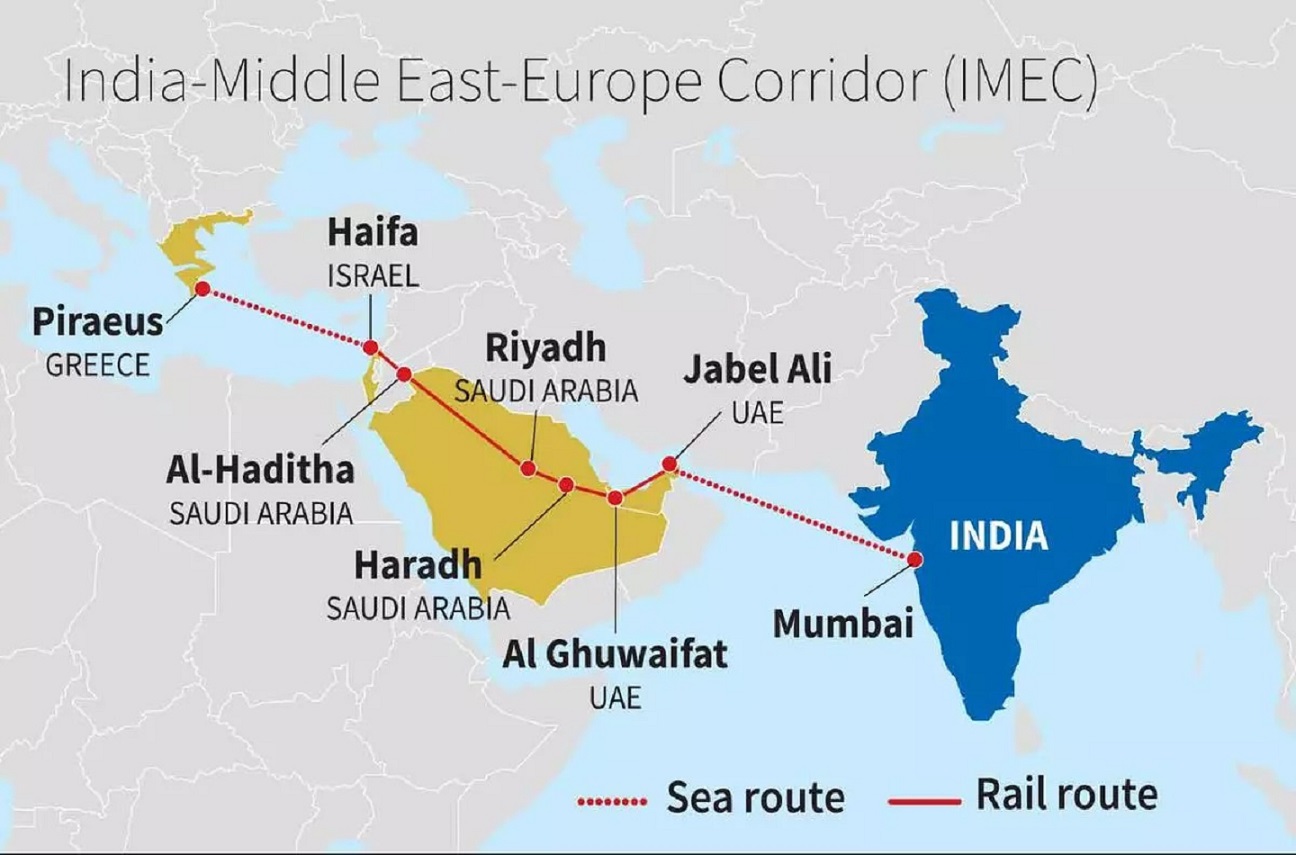The IMEC comprises two separate corridors. The east corridor will connect India to the Arabian Gulf whereas the north corridor will connect the Gulf to Europe. The IMEC could trigger economic development through enhanced connectivity by integrating South Asia, the Arabian Gulf and Europe. Can this initiative be a viable alternative to China’s One Belt One Road (OBOR)?
G20 is a group of 20 countries that are aligned with the same interests and ambitions of sustainable growth and development. The 18th Summit in New Delhi was held from September 9 to 10 making India proud and more powerful in the international arena. On the first day of the summit, the world’s geopolitical aspirants saw a number of breakthroughs and announcements, one of which was on a global connectivity corridor initiative. On the sidelines of the G20, Prime Minister Narendra Modi and US President Joe Biden co-chaired a special event on the Partnership for Global Infrastructure and Investment and the India-Middle East-Europe Corridor. At the special event, they announced their massive global connectivity initiative called the India-Middle East-Europe corridor. The MoU has been signed by India, the USA, Saudi Arabia, the UAE, the European Union, Italy, France, and Germany.
What is this Initiative?
The India-Middle East-Europe Corridor is a massive global connectivity infrastructure and investment initiative comprising two Corridors. The East corridor connects India with the Middle East and the second one is the Northern corridor which connects the Middle East with Europe. This transport connectivity corridor will connect India with Europe via the Middle East by linking the ports and rail facilities of partner nations. The UAE, Saudi Arabia, Jordan, and Israel from the Middle East, the European Union, and the USA are also partners in this corridor, aspiring to a massive flow of goods, services, technologies, and energy between the East and the West. By taking this initiative, they aim to reduce shipping and transportation costs and aims to attain the SDGs (Sustainable Development Goals) and offer prosperity to all nations across the world, especially the global south.
An Alternative to China’s BRI?
Even though it’s an important project for global connectivity, the two important nations have not waved the green flag. They were China and Russia because this connectivity project is a direct message or a threat to Chinese President Xi Jinping’s trillion-dollar connectivity project called the Belt and Road Initiative. If this connectivity project comes into action, it will affect China’s emerging clout in the Middle East and its trade flow. When compared to these two, the BRI (Belt and Road Initiative) is lagging behind in terms of transparency, and some countries are in fear of debt traps. For example, the situation in Sri Lanka and the sinking economy of Pakistan are two important partners for China. A major player, Italy, decided to walk out of the BRI initiative recently, but in the case of the IMEC (India, Middle East, and Europe Corridor), they are offering transparency in trade and connectivity-related matters. India is an important decision-making authority in the initiative. With the presence of India, trust will build among the member countries, especially in the global South.
US Interests
This initiative is basically US-oriented. US President Joe Biden’s National Security Advisor Jake Sullivan noted that this reflects the ‘president ‘s vision for “far-reaching investments” that come from “effective American leadership” and a willingness to embrace other nations as partners. With the interest of the West, India’s human-centric approach is also a major component of this initiative. If this transport corridor came into effect, India would get more tilted towards the West. India has already become a top partner of the US in defence cooperation. Modi-Biden Bilateral on the sidelines of the G20 focussed on major defence and security. This ongoing development in the relationship with the US can affect India’s relations with their traditional partner, Russia, but I think Moscow will respect New Delhi’s strategic autonomy in this matter.
The inclusion of the Middle East could bring a truce between the fighting arab nations and can bring permanent peace between US ally Israel and the Arabs. Saudi Arabia has reestablished diplomatic links with Iran and China. By bridging Tel Aviv with Riyadh, Washington can revive its old glory and clout in the Middle East.
Conclusion
The future of the IMEC (India Middle-East Europe Corridor) is uncertain. It is still in its early stages, and it is not yet clear how it will be implemented. However, the IMEC has the potential to be a major game-changer in global connectivity. Greece is likely to join the project in the future. A robust transit network includes shipping routes between India and Saudi Arabia and a rail connection to the UAE extending to Jordan and Israel. From Jordan, shipments will proceed by sea to Turkey inland via rail. The Dubai port, particularly Jebel Ali port may play a key role in connecting UAE and India. India may get connected from either Kandla/ Mundra or JNPT port.
Title Image Courtesy: The Hindu Business line
Disclaimer: The views and opinions expressed by the author do not necessarily reflect the views of the Government of India and Defence Research and Studies
Reference
- The United States Government. (2023, September 9). Memorandum of understanding on the principles of an India – Middle East – Europe economic corridor. The White House. https://www.whitehouse.gov/briefing-room/statements-releases/2023/09/09/memorandum-of-understanding-on-the-principles-of-an-india-middle-east-europe-economic-corridor/
- Al Jazeera. (2023, September 9). “game-changer”: India-middle East economic corridor unveiled at G20. News | Al Jazeera. https://www.aljazeera.com/news/2023/9/9/g20-summit-transport-project-to-link-india-to-middle-east-europe-unveiled





